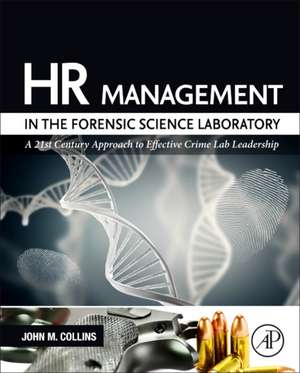HR Management in the Forensic Science Laboratory: A 21st Century Approach to Effective Crime Lab Leadership
Autor John M. Collinsen Limba Engleză Hardback – 8 feb 2018
- Provides principles of HR management that readily apply to the practice of forensic science
- Covers and emphasizes the knowledge necessary to make HR management in the forensic science laboratory effective, such as technical standards and practices, laboratory structures and work units, and quality system management
- Includes an online website that hosts workshop PowerPoint slides, a forensic HR newsletter and other important HR strategies
Preț: 419.61 lei
Preț vechi: 478.88 lei
-12% Nou
Puncte Express: 629
Preț estimativ în valută:
80.35€ • 82.88$ • 66.59£
80.35€ • 82.88$ • 66.59£
Carte tipărită la comandă
Livrare economică 13-27 februarie
Preluare comenzi: 021 569.72.76
Specificații
ISBN-13: 9780128012376
ISBN-10: 0128012374
Pagini: 530
Dimensiuni: 191 x 235 x 32 mm
Greutate: 1.16 kg
Editura: ELSEVIER SCIENCE
ISBN-10: 0128012374
Pagini: 530
Dimensiuni: 191 x 235 x 32 mm
Greutate: 1.16 kg
Editura: ELSEVIER SCIENCE
Public țintă
Forensic lab directors and supervisors overseeing operations, HR Managers and analysts of forensic operations in public / private sectors. In addition, instructors and students in forensic mgmt. courses and new forensic professionals.Cuprins
PART I. INTRODUCTION1. Forensic Science and the Promise of HR2. The Story of Forensic Science3. Crime Scenes and Evidence Categories
PART II. LABORATORY OPERATIONS4. Evidence Triage and Intake5. Case Management and Customer Service6. Special Case Circumstances and Considerations7. Occupational Outlook8. Professional Standards and Governance9. Reporting of Conclusions and the Art of Consulting
PART III. JOB ANALYSIS AND STAFFING10. Core Competencies and Education11. Job Descriptions and Requirements12. Recruitment, Evaluation, and Selection13. Employee Onboarding and Training14. Organizational Structuring and Work Units15. Overtime, Flexibility, and Alternative Staffing
PART IV. ACCOMMODATIONS AND ENVIRONMENT16. Health and Safety17. Physical and Sensory Challenges18. Mental and Emotional Health
PART V. LABOR RELATIONS 19. Job Compensation and Classification20. Unions and Collective Bargaining21. Performance Review and Appraisal22. Progressive Discipline23. Malpractice and Misconduct24. Outside Employment (Moonlighting)
PART VI. HIGH-STAKES LEADERSHIP25. Ethics, Integrity, and Independence26. Accreditation27. Developing Future Leaders28. Strategic Positioning
PART II. LABORATORY OPERATIONS4. Evidence Triage and Intake5. Case Management and Customer Service6. Special Case Circumstances and Considerations7. Occupational Outlook8. Professional Standards and Governance9. Reporting of Conclusions and the Art of Consulting
PART III. JOB ANALYSIS AND STAFFING10. Core Competencies and Education11. Job Descriptions and Requirements12. Recruitment, Evaluation, and Selection13. Employee Onboarding and Training14. Organizational Structuring and Work Units15. Overtime, Flexibility, and Alternative Staffing
PART IV. ACCOMMODATIONS AND ENVIRONMENT16. Health and Safety17. Physical and Sensory Challenges18. Mental and Emotional Health
PART V. LABOR RELATIONS 19. Job Compensation and Classification20. Unions and Collective Bargaining21. Performance Review and Appraisal22. Progressive Discipline23. Malpractice and Misconduct24. Outside Employment (Moonlighting)
PART VI. HIGH-STAKES LEADERSHIP25. Ethics, Integrity, and Independence26. Accreditation27. Developing Future Leaders28. Strategic Positioning
